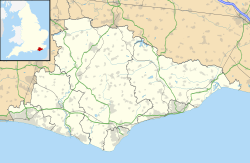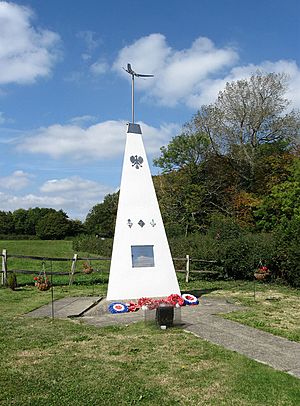RAF Chailey facts for kids
Quick facts for kids RAF Chailey
|
|||||||||
|---|---|---|---|---|---|---|---|---|---|
| Chailey, East Sussex in England | |||||||||
|
Shown within East Sussex
|
|||||||||
| Coordinates | 50°57′19″N 000°03′20″W / 50.95528°N 0.05556°W | ||||||||
| Type | Advanced Landing Ground | ||||||||
| Code | AJ | ||||||||
| Site information | |||||||||
| Owner | Air Ministry | ||||||||
| Operator | Royal Air Force | ||||||||
| Controlled by | RAF Second Tactical Air Force * No. 84 Group RAF RAF Fighter Command No. 11 Group RAF |
||||||||
| Site history | |||||||||
| Built | 1943 | ||||||||
| Built by | RAF Airfield Construction Service | ||||||||
| In use | June 1943 - January 1945 | ||||||||
| Battles/wars | European theatre of World War II | ||||||||
| Airfield information | |||||||||
| Elevation | 32 metres (105 ft) AMSL | ||||||||
|
|||||||||
RAF Chailey was a special kind of airfield used by the Royal Air Force during the Second World War. It was located near the village of Chailey in East Sussex, England. This airfield was known as an Advanced Landing Ground (ALG). ALGs were simple, temporary airfields. They were built quickly to help support the invasion of Europe.
History of RAF Chailey
This airfield was built on land that used to be Bower Farm. The idea for an airfield here started in 1942. At first, it was planned to be a fighter base. This was part of a bigger plan to expand the air force after the Battle of Britain.
Building the Airfield
Construction of RAF Chailey began in 1943. By then, the war strategy had changed. The airfield was then given to the RAF Second Tactical Air Force. Its new purpose was to support the invasion of mainland Europe. This huge invasion was secretly called Operation Overlord.
To build the airfield, a local pub called 'The Plough' had to be moved. It was right at the end of the runway! The pub was taken down and rebuilt about half a mile away. Today, this new pub location is where you can find the RAF Chailey memorial.
Who Served at RAF Chailey?
RAF Chailey became home to No. 131 Airfield RAF. This unit later became known as No. 131 (Polish) Wing. It included three important squadrons:
- 302 Squadron
- 308 Squadron
- 317 Squadron
These squadrons were made up of brave Polish pilots. The highest-ranking Polish officer in the RAF, Group Captain Aleksander Gabszewicz, was in charge of the station. The airfield also hosted No. 1312 Mobile Wing RAF Regiment.
After the War
After the war ended, RAF Chailey was no longer needed for military use. In 1945, the land was given back to its original owners. It then went back to being used as farmland.



